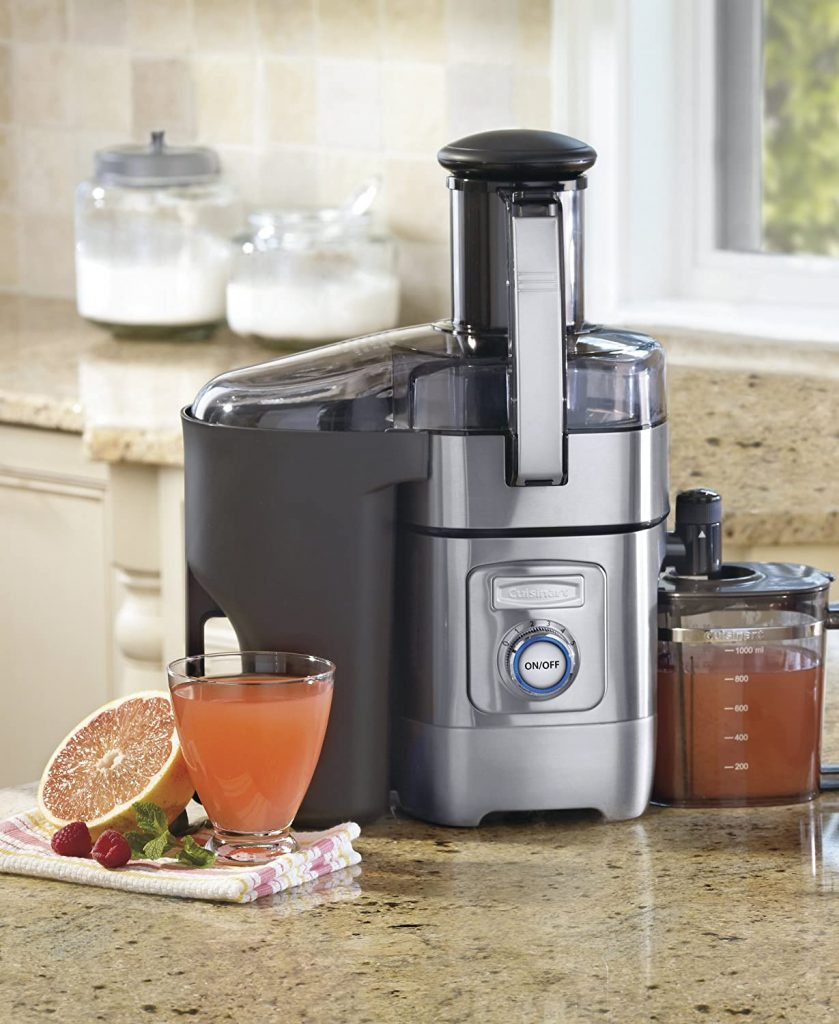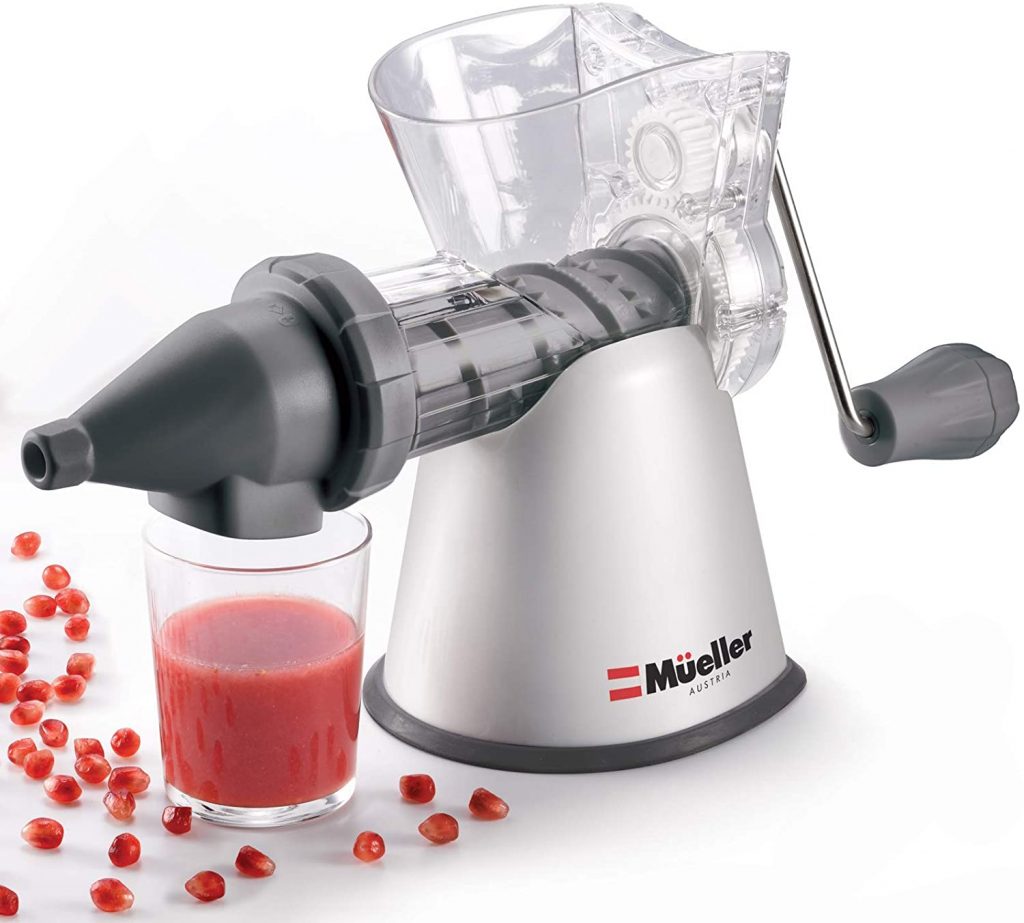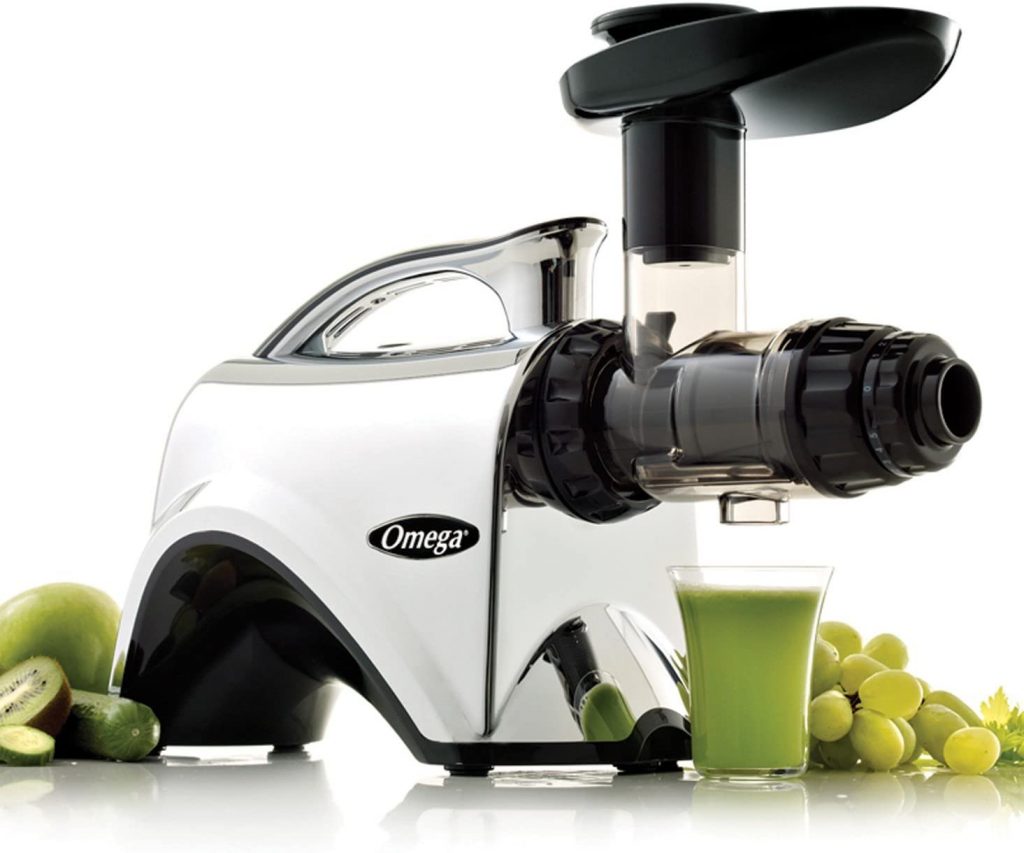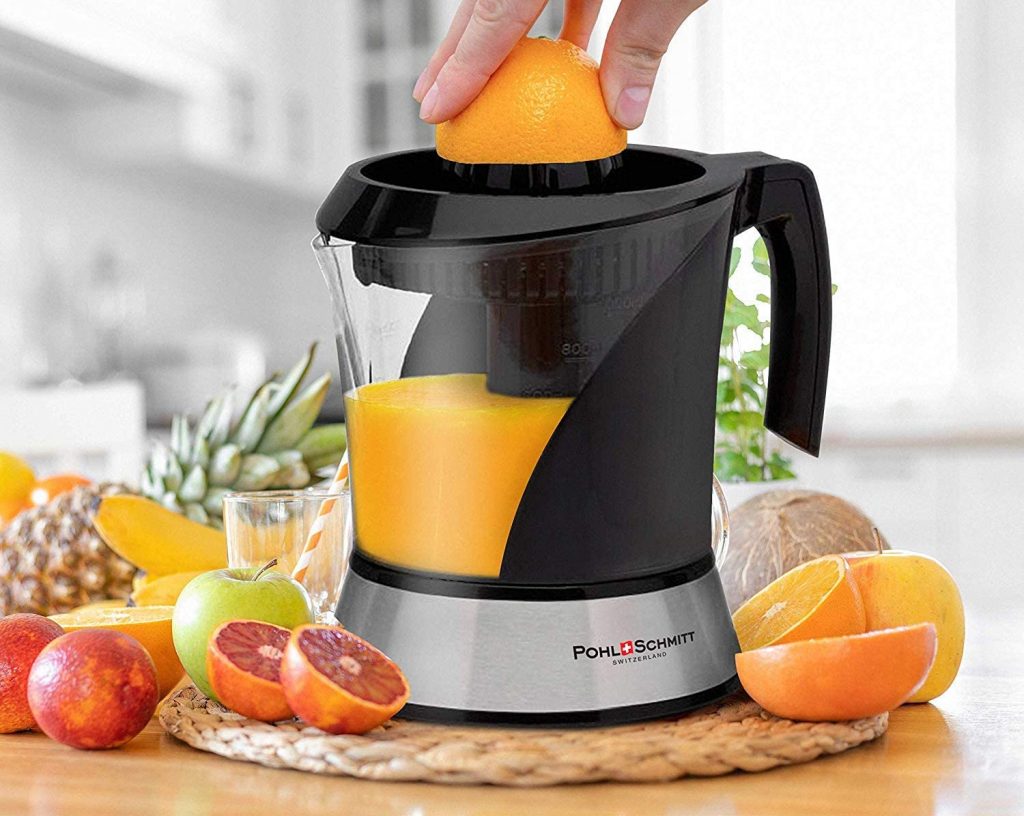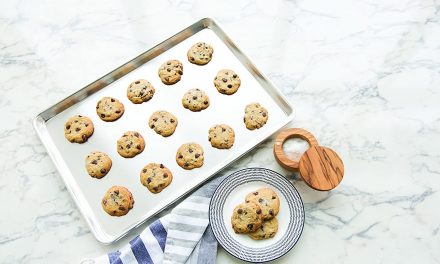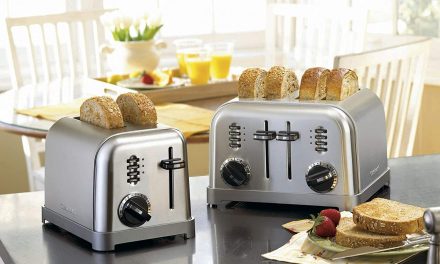Centrifugal? Masticating? Cold press? Let’s face it—home juicing and juicers can be complicated. But it’s not a fad; it’s here to stay. In truth, juicing started in earnest in the 1950s and shows no signs of slowing down. From childhood apple juice cartons and juice cleanses to Jamba Juice, we’re wild about juice. It’s even the fifth most popular non-alcoholic beverage among Americans.
At the same time, though, we’re still not getting enough fruits and vegetables. The USDA recommends five to nine servings every day, but only 1-in-10 Americans are measuring up. From the breakfast bowl to the dinner table, there are plenty of places where we can all do better to get enough. And juice can be a part of that.
But you don’t have to go out to fulfill your juice cravings. In fact, not only can you make juice in your home kitchen, but you might just find it tastes better than anything you could buy at the store. And, with today’s modern home juicers, you can get that fresh-made taste without too much hassle.
Types of juicers
There are four main types of juicers, all with their advantages and disadvantages. Centrifugal juicers are a popular, affordable option. Masticating and twin gear juicers are great for the juice aficionado. We’ll also take a look at cold press and citrus juicers. Whatever your juice needs, there’s a juicer that’s right for you!
Centrifugal juicers
Centrifugal juicers work a lot like food processors, but in hyperdrive. Rough-chopped fruits and vegetables are fed through the top into a spinning chamber, where a blade cuts them finer. Then the force of the spinning pushes the vegetable matter outward against a screen. The juice that is squeezed through this screen is then ejected through the spout.
Centrifugal juicers are a great option for the casual juicer, being the most affordable and widely available type. They’re also fast, due to the rapidly spinning blades, but can be a bit loud. They’re not the best for wheatgrass or leafy greens, like spinach and kale. And the speed of the rotation means the juice separates faster and may require stirring. It won’t keep that fresh-made flavor for more than a few hours.
The Hamilton Beach Juicer Machine is our pick for the best affordable centrifugal juicer that’s easy to clean. For another option under a hundred dollars, try the Breville Juice Fountain Compact for a well-made juicer with a wide, three-inch (7.6cm) feed chute that won’t break the bank. For those who want the affordability and ease-of-use of a centrifugal juicer but love kale and wheatgrass, try the Cuisinart Juice Extractor. It has five speed settings for whatever you need to juice.
For unparalleled versatility, get the NOVIS 4-in-1 Vita Juicer. Not only does it juice, it also makes purees from hard-to-juice fruits like berries and bananas. It even has a citrus press for everything from limes to grapefruit. Choose pulp, low pulp, or no pulp options for the perfect citrus experience. And for families, we suggest the Breville Juice Fountain. It has the three-inch (7.6cm) feed chute common to most Breville models and also comes with a 70 fl. oz. (2.1 L) jug for refrigerator storage.
Pros:
- Fast
- Juice the hardest vegetation
- Don’t take up very much counter space
- Affordable
Cons:
- Higher oxidation may degrade nutrients faster than other types
- Juice quality deteriorates after a few hours
- Yield can be lower than other types
- Not great for leafy greens
- Tend to be loud
Price Range: $40-$300 for bestselling centrifugal juicers on Amazon
Gear juicers and juice pressing
How pulp is separated from juice is what determines whether a juicer is a press. Many masticating juicers and twin gear juicers make claims about being cold press juicers, but they may not be true presses.
Keep reading to learn more about the differences between these juicers.
Masticating juicers
Masticating juicers are named for the way they masticate—”chew”—what you put into them with their single gear/auger. First, a masticating juicer grinds the fruits and vegetables, then it pushes the vegetation down and against a screen. The juice that’s pushed through the screen is then ejected through the spout. Because of how they’re designed, masticating juicers can juice everything from carrots to celery to kale. Some can grind coffee beans and grains. Still others can make nut butters and fresh pasta.
Generally, masticating juicers are more expensive than centrifugal juicers, though they make up for it with high quality, low-oxidized juice and great versatility. If you’re looking for a budget option, try the Mueller Masticating Slow-Juicer. It’s hand-cranked and can’t do everything the pricier models can, but it’s solidly built, easy to clean, and only twenty dollars, making it cheaper even than centrifugal juicers. The NXONE Slow Masticating Juicer is another good option that’s less than a hundred dollars.
For the real slow juicer experience, try the Omega Dual-Stage Masticating Juicer. It offers great versatility and produces a high yield. For a high quality, easy-to-clean masticating juicer, try Hurom’s slow juicers or the Nama Cold Press Juicer. And for a tough juicer you’ll be using for years to come, you can’t go wrong with a Champion Juicer. They’ve been made in the USA since 1955.
Pros:
- Better with leafy greens and wheatgrass
- Can sometimes be used as a grinder
- Lower oxidation means more nutrients are preserved
- Juice stays fresh for a couple of days
- Usually easy to clean
Cons:
- Slower than centrifugal juicers
- Don’t produce as high a yield as twin gear juicers
- Not all models can handle hard nuts and grains
Price Range: $80-$520+ for the bestselling masticating juicers on Amazon
Twin gear (triturating) juicers
Twin gear juicers work a lot like masticating juicers (and sometimes are also referred to as ‘masticating’), but they have two gears/augers instead of one. The two gears grind the fruits and vegetables against each other, as well as against the walls of the chamber. Then, the gears pull the vegetation down against a screen. The juice that’s pushed through the screen is ejected through the spout.
While twin gear juicers work similarly to masticating, single gear juicers, they are generally more efficient. Twin gear juicers are also called ‘triturating’, referring to their ability to pulverize and powder whatever is put into them. Twin gear juicers have a wider range of uses than other kinds of juicers. With the right attachment, you can juice, puree, mash, and grind. You can even make nut milks and butters!
For a more affordable option that still works well, try the Green Power Twin Gear Juicer. The Omega Twin Masticating Juicer is another good option for anyone who wants the quality experience of a twin gear juicer for less than five hundred dollars.
If you’re a serious juicer, dealing with quantity as well as quality, try the Tribest Jumbo Twin Gears Extractor. The Super Angel Juicer is another great option for heavy-duty juicing. But our pick for the best overall twin gear juicer is the Tribest Cold Press Complete Masticating Slow Juicer. It’s efficient, versatile, easy to use, and easy to clean!
Pros:
- Best with leafy greens and wheatgrass
- Can often be used as a grinder
- Can be used to make nut milks and butters
- Low oxidation means high quality juice
- Juice stays fresh for a couple of days
Cons:
- Even lower-end models are expensive
- Can be difficult to clean
- They usually have smaller feed chutes
Price Range: $450-$700 for twin gear juicers on Amazon
When ‘cold press’ is just a marketing term
You’ll find, when you look at masticating and twin gear juicers, that they’re often referred to as ‘cold press’ juicers. Even some of our recommended juicers make this claim. This refers to the idea that the rapid spinning of a centrifugal juicer heats up the juice, destroying some of the nutrients. The masticating and twin gear juicers, then, having a much slower rotational speed, do not heat up the juice.
But this claim is often overstated.
While it’s true that, due to friction and motor heat, the juice produced by a centrifugal juicer might be heated more than juice produced by masticating or twin gear juicers, it’s not heated enough to significantly degrade the nutrients in the juice. The important difference between centrifugal juicers and gear-based juicers is the oxidation not the heat. The much higher speeds of a centrifugal juicer (3000-10000 rpm for centrifugal as opposed to 40-100 rpm for masticating and twin gear) introduce more air into the mixture. This results in a foamier, paler juice that separates more quickly and loses its fresh taste after a few hours.
None of these are really cold press juicers, then, because they don’t really press anything. A true cold press juicer works very differently.
Juice presses (true cold press juicers)
For a long time, true cold press juicers were completely unavailable to the home juicer. Most true cold press juicers are still intended for industrial fruit juicing, not juicing on kitchen countertops.
Basically, a true cold press juicer has two parts. First, a grinder cuts the fruits and vegetables down to size, but this is not like a masticating or twin gear juicer. No juicing happens during this stage. The actual juicing happens in the bottom of the machine, where the finely-cut vegetation is funneled into a mesh bag. The bag is placed between two hard, flat surfaces, and these surfaces slowly come together with a large amount of force, pressing the juice out of the pulp.
The only real drawback is, unfortunately, the price. A true cold press juicer, such as the PURE juicer, will generally set you back at least $2,000, if not more. But if you want the highest possible quality, and if you regularly juice a large quantity of fruits and vegetables, a true juice press might be right for you.
If you’d like to test the waters of cold press juicers, but maybe not dive in, try the People’s Juice Press. It’s not a commercial juice press, hence the name, and it’s not perfect. It also doesn’t have the two-stage process of commercial models, so you’ll probably need a food processor to cut your fruits and vegetables down to size. But it’s made in the USA and retails for less than three hundred dollars.
Pros:
- Produce the highest quality, least oxidized juice
- Will handle any vegetation you throw at it
- Includes a grinder that can be used for other purposes
- Can be used to make cold-press oils
Cons:
- Very pricey
- Tend to take up a lot of space
- Mesh bags are not infinitely reusable
- Few models are available for the home kitchen
Price Range: $2000+
Manual citrus juicers
From lemonade stands to fresh squeezed orange juice, nothing beats the fresh, tangy flavor of citrus juice. Citrus juicers don’t have as many uses as regular juicers, but they’re cheaper, simpler, and sometimes faster. With a regular juicer, you usually have to peel your citrus fruit and separate it into segments before juicing. With a citrus juicer, just cut the fruit in half and you’re good to go. If you’re more interested in lemons and oranges than apples and carrots, a citrus juicer might be right for you.
So what should you look for in a manual citrus juicer?
First of all, spout-type juicers don’t work well, require excessive effort and time, and are somewhat messy. If your citrus juicer is the kind that sits on the counter, you’ll want one that comes with an attached bowl. Tabletop reamers yield on average 13% more juice than handheld reamers, while handheld reamers are cheaper, but can be extremely messy. Our suggestion for the best manual tabletop citrus juicer is the OXO Good Grips 2-in-1 Citrus Juicer.
However, the most efficient type of citrus juicer is a citrus press. Presses can be difficult to use, especially if they’re not designed well. You’ll want to look for a press that has slots instead of holes, is large enough to hold half an average-sized lemon, and, if handheld, is comfortable to hold in the hand. According to America’s Test Kitchen, the best handheld citrus press is the Chef’n FreshForce Citrus Juicer. For tabletop citrus presses, we suggest the Zulay Professional Citrus Juicer.
Price Range: $5-$130 for bestselling manual juicers on Amazon
Electric reamers
For the true citrus lover who wants their home citrus juicer to have a little more power behind it, there’s the electric reamer. Great for producing larger quantities of juice, electric reamers do the heavy lifting for you. A high quality electric reamer should produce a good juice yield and be easy to clean and use. Attached carafes are preferable as they prevent messy spills.
According to Consumer Reports, the best all-around electric reamer is the Breville Citrus Press Motorized Juicer. It’s quick, efficient, and easy to use and clean, but at around two hundred dollars, it’s not the most affordable. If that’s too pricey for you, don’t worry. The Dash Citrus Juicer Extractor is also easy to use and clean. It’s quiet, has two reamer sizes (one for small citrus, like lemons and limes, and one for larger items, like oranges and grapefruits), and is only $19.99.
Price Range: $20-$200 for bestselling electric reamers on Amazon
How juicers work
There’s four main kinds of juicer (not counting citrus juicers) and we’ll talk about them later in detail, but all of them have some things in common. Basically, fruits and vegetables are cut small—either by the juicing machine or by hand—and these small pieces are squeezed to extract the juice. All juicers include some kind of mesh that filters out the fiber, leaving you with a clear, pulp-free juice.
But juicing isn’t just about the machine. It’s also about what you put into the machine.
Fattier fruits, like avocados, don’t make good juice, and neither do bananas. These are better suited for blending. It’s also important to keep in mind that while soft fruits, like berries (as well as ripe stone fruits, like peaches, nectarines, and plums) usually can be juiced, they’re not likely to yield good results. Especially pulpy fruit often works better in smoothies than as juice, so either mix a small amount of these fruits with other, hardier vegetation for a mixed juice, stick with firmer, less ripe fruits, or buy a juicer designed to handle wetter ingredients.
Juicers vs. blenders
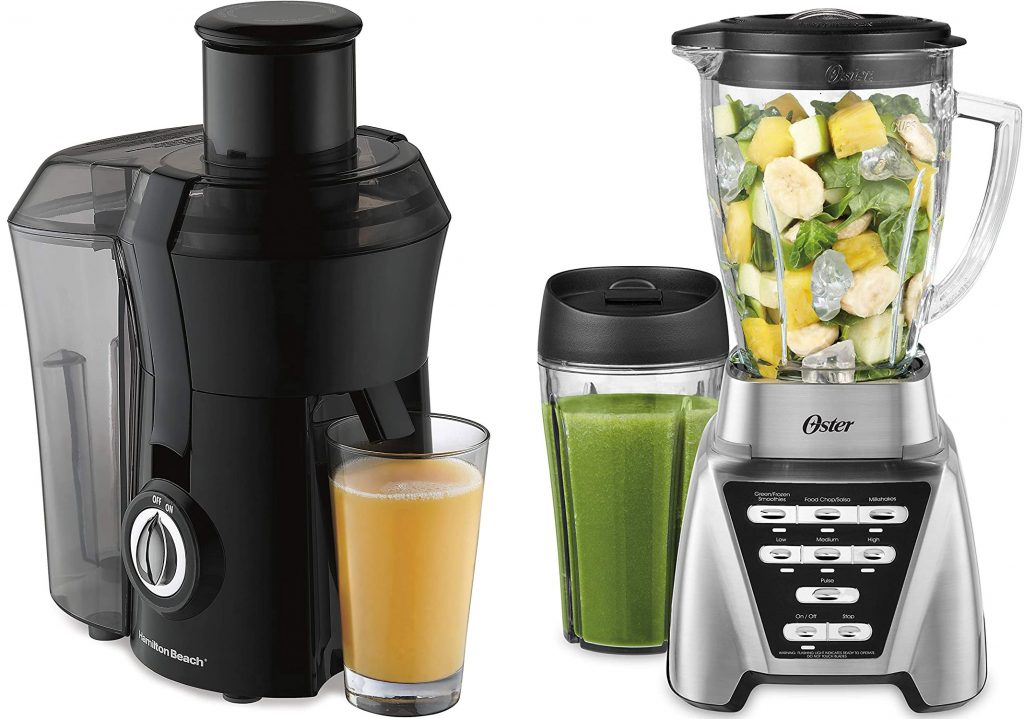
A Hamilton Beach juicer (left) vs. an Oster blender (right)
A common question in health food circles is “smoothie or juice?” Really, the answer depends on what you want to get out of your fruit. Juicers are often referred to as ‘extractors’ owing to their ability to extract concentrated nutrients from fruits and vegetables. A juicer is able to turn hard fruits and vegetables, as well as leafy greens like spinach and kale, into a nutrient-dense drink. This is great for people with weak digestion or who simply want a strong infusion of vitamins. However, juices are relatively high in sugar, and the juicing process does remove the fiber from your fruit and vegetables.
Blenders, on the other hand, are great for soft fruits, berries, nuts, milks, and various nutrient powders. Because blenders crush fruit into a puree instead of isolating the juice, soluble and insoluble fiber are both intact in blended concoctions, including smoothies. Smoothies have the best balance of micronutrients (vitamins and minerals) and macronutrients (carbohydrates, proteins, and fats) and tend to have less sugar by volume than juice, but you’ll need to pace yourself with them if you don’t want to consume too many calories and nutrients at once.
Which one is better? Really, it depends on what you want. If you want a balance of vitamins, minerals, carbs, and fat, you’ll want a blender-made smoothie. But if you want fast nutrients and fast energy, juices (and juicers) are the way to go.
Juicing for every diet
From weight loss to cleanses to healthy snacks that taste great, there’s a rainbow of juices (and more) at your fingertips!
Juicer starter kit
Need the info condensed? Here are the highlights.
- Juicing and blending have a lot in common, but while juicers filter out the fiber, blenders keep the whole food. Which one is best depends on what you’re looking for.
- Focus on harder fruits and vegetables for lower-end juicers, but for the top models the sky’s the limit.
- If you’re a beginner, get a Breville Juice Fountain Compact. If you’re looking for something with a little more versatility, try an Omega Dual-Stage Masticating Juicer.
- For citrus, get the Chef’n FreshForce Citrus Juicer. It’s the best all-around and super affordable.
- Get a good juicing book.
Now get to juicing!


